Digital Out-Of-Home (DOOH) screens and displays
Digital Out-Of-Home (DOOH) screens and displays have appeared in the streets, stadiums and rooftops only recently but since then have become a permanent feature. While we stand in traffic jams, wait for a bus or chain-smoke waiting for a girlfriend, they entertain us, inform and help to spend the time. Most importantly, digital screens and displays are an effective advertising media for DOOH. For this reason outdoor electronic video systems more and more frequently become the “talk of the town”. Information and advertising systems based on electronic screens and displays have introduced a novel type of outdoor advertising – “digital outdoor advertizing”. DOOH screens and displays may be stationary or mobile, wall or roof installations: their efficiency is extremely high everywhere.
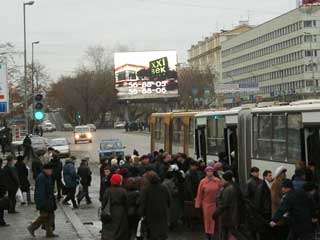 |
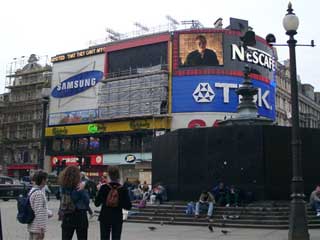 |
| Huge digital lamp screen in Ekaterinburg, Russia | Giant digital LED screen in London |
Digital outdoor screens and displays become an attractive feature of town architecture; they are decorations and business cards of New York (famous Times Square advertizing screens and displays), Las Vegas, Tokyo, and Seoul. They are installed at the rail terminals in England, France, Germany, China, Korea, at the entrance to Disney Land in Florida, at all major stadiums and concert halls around the world, on lively highways, on office headquarters of various companies, in front of restaurants, hotels and casinos.
Digital out-of-home displays are one of the most interesting and attractive media carriers. Unlike common street installations (including neon signs, 3D light letters and billboards), digital screens are capable to display live video, multimedia animation, color dynamic materials. They make updating of advertising materials routine and easy, thus turning into the most popular outdoor advertising media. These huge “outdoor television sets” attract attention of millions of people due to dynamic colored video and TV images.
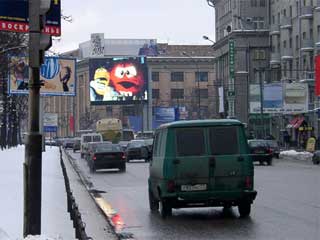 |
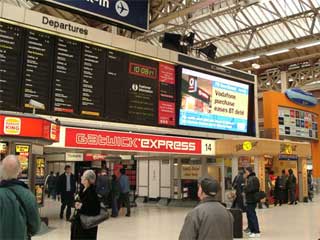 |
| Giant advertizing lamp screen in Moscow (Russia) | Large indoor digital LED screen at the Victoria railway station in London |
Application of large digital displays and screens
Digital outdoor displays: Who buys and for what purpose?
All around the world electronic outdoor displays are used primarily as an advertising carrier. However they become more and more useful informational tools at sports competitions, concerts, shows and other mass events, including political campaigns.
Public, political and municipal information
Digital outdoor displays are capable to broadcast live video and TV signals which makes them indispensable during public and political events. National and municipal holidays, international festivals and presidential campaigns – this is only a short list of events serviced by digital outdoor displays and screens as a means of additional artistic influence and as carriers of useful information. Information on large outdoor digital screens reaches hundreds of people simultaneously, even those who stand far from the stage or the center of action. An electronic digital screen or display in a town quickly becomes an important meeting place and a new mass media – town television.
Large digital display screens for concerts and shows
Few concerts and mass rallies are conducted without large digital display screens. Large displays, like binoculars, allow to watch performers and popular stars clearly even when the seats are too far away from stage. Nobody would dispute the need for modern computer informational systems with large digital screens capable of reproducing video signals, live broadcasts and instant replays of the most interesting episodes. And sponsors love to see their advertising on screens in front of the large and well-warmed up audience!
Sport displays and stadium screens
Many stadiums and sports clubs are loosing money due to poor attendance. How to attract people to sports events? How to receive maximum profit from the events organized? Quite a few club owners realize that installing large digital screens and displays helps to remedy their problems. The displays work as huge TV sets showing athletes’ close ups and replays, and show commercials during breaks. All that makes the events more colorful and brings additional revenues to stadium owners. Statistically, digital advertising during sports events is more effective than the usual advertising by 30%.
Digital out-of-home displays and screens: Other fields of application
The areas of application for large electronic screens are very wide. For example, they are used as intellectual road sign systems, informational displays at airports and railway terminals, in various enterprises, including electric power stations.
Digital screens for business and advertising
Electronic screens and displays proved most useful for business and are generally used by:
- Advertising companies that sell advertising time (almost 24 hours a day) for profit;
- Large companies, banks, publishing houses, restaurants, hotels, casinos etc. to attract clients and promote their goods and services.
What makes electronic screens and displays so effective?
- Broadcasting real time video signals, including TV programs and TV advertising;
- Advertising rates drastically cheaper that on TV and radio;
- Attracting attention of passersby without alienating or annoying them as often happens during TV programs;
- Digital screen dynamic animation that is more attractive and appealing than any standards static outdoor billboards;
- Capability of correcting displayed information or adding to it in real time that is especially useful during intensive political or advertising campaigns;
- Allocating digital advertising spots in a flexible mode and changing advertising programs depending on specific requirements and changing conditions.
Technologies of large digital screens and displays
Digital LED screens
Light-Emitting Diode (LED) screens have become especially popular in South-Eastern Asia (Korea, China, Indonesia, and Japan). It sounds incredible but only a few years ago there were no full-color LED screens anywhere in the world. And only when a bright dark-blue diode was developed, nothing could hold back the advance of LED screens. The world seemed to have turned around.
Digital LED screens possess high resolution that make them attractive in practically all sites. The LEDs are manufactured in Japan, USA, Germany, Korea, Taiwan and other countries. Compared to lamps, LEDs consume less energy and serve longer (up to 100,000 hours of uninterrupted life). It is not surprising that many manufacturers decided that LED screen technology is capable to meet all technical and pragmatic requirements in outdoor informational and digital advertising sphere. However any new technology possesses some peculiar features and customers must be aware of them.
In spite of extremely good theoretical characteristics, digital LED screens proved not so easy to operate and maintain. This does not mean that LED screens are bad. Unfortunately, practical experience demonstrates that these screens are not a panacea; they failed to satisfy every dream of customers. Among the myths that have enveloped LED screens are the following:
- LED screen long life
Well, some LED screen digital systems have been operating for 4-5 years. The catch is that all of them have lost much of their initial brightness over that time. The dimming of screens is highly noticeable and cannot be remedied by anything short of changing the whole LED screen surface. The manufacturers do not mislead customers: LEDs do operate 100,000 hours. However, unlike lamps that simply blow out, LEDs lose brightness which is most visible in case of round-a-clock operation mode.
It is important to remind here that a screen does not consist of diodes or lamps only. The screen is a combination of light-emitting elements, electronic part and climatic systems, metal structures, etc. That is why the life of a screen depends on life of all of its components.
- LED screen lower energy consumption
Super bright LEDs consume quite a lot of energy. Moreover, LED digital systems possess very high resolution, i.e. the number of energy consuming elements quadruples. As a result, LED screens of consume similar amounts of energy compared to systems of similar linear dimensions based on other technologies.
- Fast reduction of prices
Customers should remember the rule common to all high technologies: prices only fall when the product goes out fashion. It is a pity that digital LED screens failed to become revolutionary technology “good for all”. But they have earned a good reputation as mobile systems and as systems of mid-sizes. In all such cases LED screens are the natural choice.
The newest lamp screens
Lamp systems are surrounded by numerous interesting and even incredible stories. Until late 1980ies these they remained the only electronic digital systems in outdoor advertising. With the appearance of blue LED the world seemed to have forgotten the “old workhorse” of outdoor advertising and rushed on to a new fad.
A few years later when LED systems have been shown to possess drawback as well as clear advantages, public attention to lamp screens returned. But the three years of public disregard did not pass in vain. During that time the lamp technology has made a leap forward and has visibly transformed. Lamp screen systems became as effective and reliable as the most expensive, modern and prestigious LED systems, if not more so.
Today, lamp screen is the only type of electronic display capable of operating in conditions of extreme continental climates (from –60°C to +50°C) in a non-stop mode for 4-5 years without major repairs. Lamps have also chained: they became brighter and their life was increased to 20,000 hours, i.e. more than 3 years of continuous operation. Reliability, easy maintenance procedures, modular construction principle – these are the advantages of lamp screens that make them popular choice for many applications.
New printed boards, new processors, more sophisticated software turn lamp screen digital systems into full-color installations with live video and TV broadcast capabilities. Comparatively lower price and short manufacturing time make them even more attractive. The return-on-investment in lamp screens is much faster and makes them affordable to more potential customers than for LED screens.
All this has become possible due to continued research of some companies in Canada, the USA and Russia. Their efforts have resulted in products that left behind even such respectable world leaders in high tech area as Sony and Panasonic. It is for this reason that many large companies equip their office centers and headquarters with lamp screens (for example, Times Square in New York). Countries with difficult climatic conditions – Canada and Russia - also primarily use lamp screens.
In all new lamp systems the large linear dimensions ensure better resolution and longer viewing contact. Thus, their advertising and informational effect on people is much higher compared to smaller digital screens. At the same time their price per 1 sq. meter is significantly lower than that of LED screen systems.
It is obvious that in all cases when you are planning to install a large display (for example, 9x12 meters) you must go for a new generation full-color lamp screen. That concerns all cases of roof installations, on major highways and large squares where smaller dimensions would be simply ineffective, while LED screens of required sizes would become prohibitively expensive.
Plasma display screens
Over the years, plasma display screens proved to be too sensitive to environment conditions: controlling boards frequently blow out mostly due to surges in electricity supply. One gas-discharge lamp operates for approximately 2000 hours of continuous operation which is nearly 10 times less than the life of modern lamp. Moreover, these digital screens need climatic systems to equalize temperature regime, and as a result fairly high energy consumption.
Competition
We must not forget that competition is fierce even in this fairly new technological sphere. New solutions and ideas appear almost daily. Sizes are getting bigger. The Japanese industrial giants started their attack on the world market. Here is statistics about large digital displays and screens (over 100 square meters!) manufactured in Japan and already installed throughout the world: Sony – 10 (including a huge 196 sq. meters screen in Germany), Matsushita Electric Industrial – 4, Mitsubishi Electric – 2.
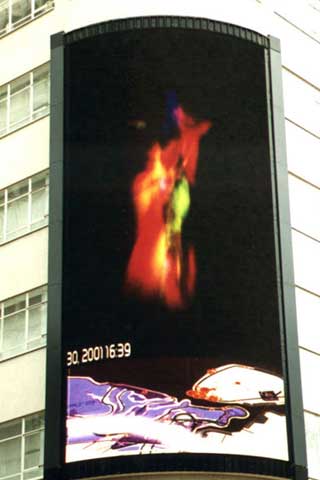 |
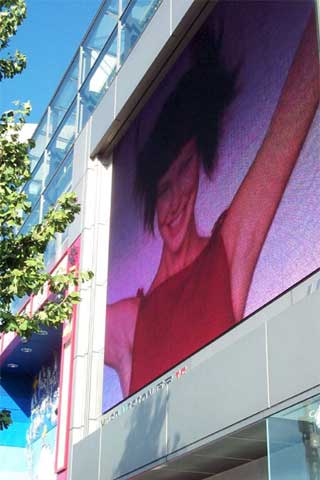 |
| Large LED display for outdoor advertising in London | Large outdoor LED display for advertising in Tokyo |
US businesses are always very sensitive to new trends: so, digital advertizing screen sizes started to grow in the US, too. The official site of the Outdoor Advertising Association of America ventures the opinion that “size is all-important for outdoor digital advertising efficiency”. Large size is absolutely indispensable for the effective influence on consumers. The bigger the screen, the longer the eye contact with it, the higher the advertising effect, and the more information is subconsciously absorbed by potential viewers.
Billboards appeared about 100 years ago. Much has changed since then. The outdoor digital advertising technologies have transformed drastically: from large placards glued to house walls to huge boards hanging over highways. Even more noticeable is the change in content. Outdoor advertising is extremely effective in attracting attention – digital screens grab you, they make you look, they brand! Add to that the newest technological enhancements and you have a veritable theater in the streets.





